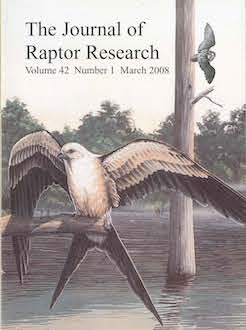We quantified predation on Swallow-tailed Kite (Elanoides forficatus) eggs, nestlings, fledglings, and adults on the breeding grounds, Louisiana and Mississippi, U.S.A. Methods included monitoring nests and radio-tagged kites, as well as using Principal Components Analysis to quantify the mobbing intensity of adults toward potential avian predators and other birds that approached nests. We detected 65 predation events while monitoring 317 nesting attempts (1997–2006) and 103 radio-tagged kites (90 fledglings, 13 breeding adults). Predation-related mortality (108–116 depredated kites and eggs) was caused primarily by raptors: 46.0–46.7% by Great Horned Owl (Bubo virginianus), 1.7–1.8% by Barred Owl (Strix varia), 0.9% by a Red-shouldered or Broad-winged Hawk (Buteo lineatus, B. platypterus), and 44.9–45.3% by unidentified raptors. Climbing predators were responsible for the remaining predation: 5.1–6.1% by North American rat snakes (Pantherophis [= Elaphe spp.]) and 0.9% by raccoon (Procyon lotor). Kite mobbing behavior during nest defense confirmed the importance of the two owl predators and implicated additional avian predators (e.g., Bald Eagle [Haliaeetus leucocephalus] and Red-tailed Hawk [B. jamaicensis]) not detected through other methods, although kites sometimes mobbed nonpredators. Altogether, the combined methods indicated that the Great Horned Owl is not only the most frequently documented predator of the Swallow-tailed Kite population under study, but also the only predator known to kill kite adults.
How to translate text using browser tools
1 March 2008
Predators of the Swallow-Tailed Kite in Southern Louisiana and Mississippi
Jennifer O. Coulson,
Thomas D. Coulson,
Sherry A. DeFrancesch,
Thomas W. Sherry

Journal of Raptor Research
Vol. 42 • No. 1
March 2008
Vol. 42 • No. 1
March 2008
Bubo virginianus
Elanoides forficatus
great horned owl
mobbing
predation
predator identification
Swallow-tailed Kite




